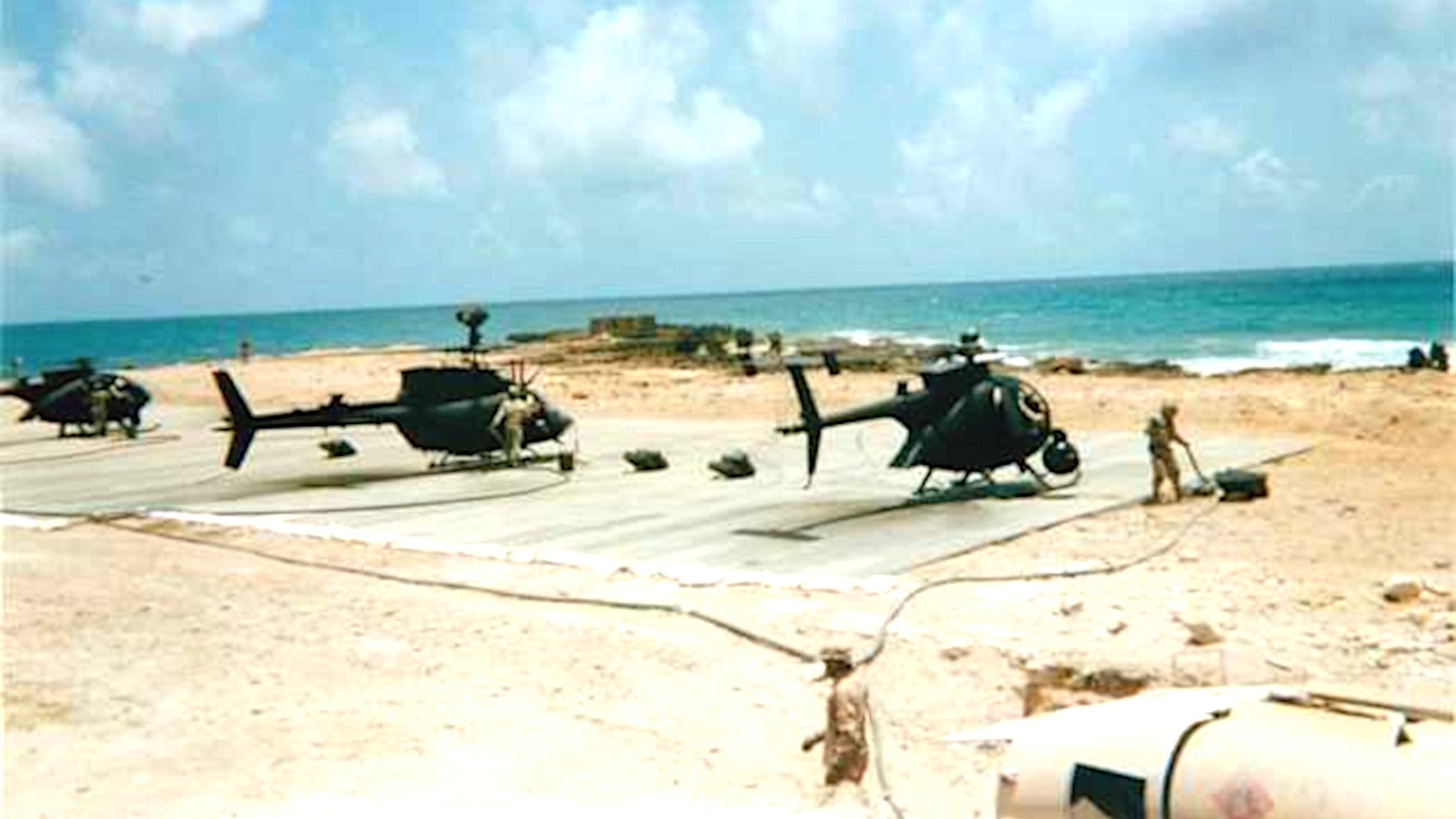In August 1993, a joint U.S. special operations force, known as Task Force Ranger, with personnel from elite units across the services, deployed to Somalia. Its principal objective was to hunt down and capture warlord Mohammed Farah Aidid and other senior militants responsible for orchestrating attacks on U.S. and U.N. personnel in the country. It is well known that this task force included special operations helicopters from the U.S. Army’s elite 160th Special Operations Aviation Regiment, which infamously lost two MH-60 Black Hawks in the aftermath of one raid. This event is now known commonly as the Battle of Mogadishu or the Black Hawk Down incident. But there is also significant evidence that it also received support from two Little Birds from one of the U.S. military’s most top-secret aviation units, the Flight Concepts Division.
There are limited pictures and video from Task Force Ranger’s deployment to Somalia, also known as Operation Gothic Serpent, in general. The operation began with the departure of an advance party on Aug. 22, 1993, and lasted until mid-October 1993. The 160th Special Operations Aviation Regiment (SOAR) provided the bulk of the organic aviation support for the force with a mix of MH-60 Black Hawks and AH-6 and MH-6 Little Birds.
Task Force Ranger also included a squadron from the Army’s secretive Delta Force and a company from that service’s elite 75th Ranger Regiment. There were also additional personnel from the U.S. Navy’s Special Warfare Development Group (DEVGRU), better known as SEAL Team Six, and the U.S. Air Force’s 24th Special Tactics Squadron. The U.S. Special Operations Command’s Joint Special Operations Command (JSOC) oversaw the task force, with U.S. Army Major General William Garrison, JSOC’s commander at the time, going to Somalia himself to lead the operation.
But at least two undated images from the operation show another pair of mysterious Little Birds with some small, but distinct differences from those assigned to the 160th Special Operations Aviation Regiment (SOAR). Unlike their light attack and light assault cousins, these aircraft appear to have been highly specialized intelligence, reconnaissance, and surveillance platforms with then state-of-the-art equipment.
Covert intelligence gathering platforms
The first of the available images, seen at the top of this story and below, shows the two Little Birds at a seaside Forward Arming and Refueling Point (FARP), along with an OH-58D Kiowa Warrior. The Kiowa Warrior is another important piece of this story, but more on that later.
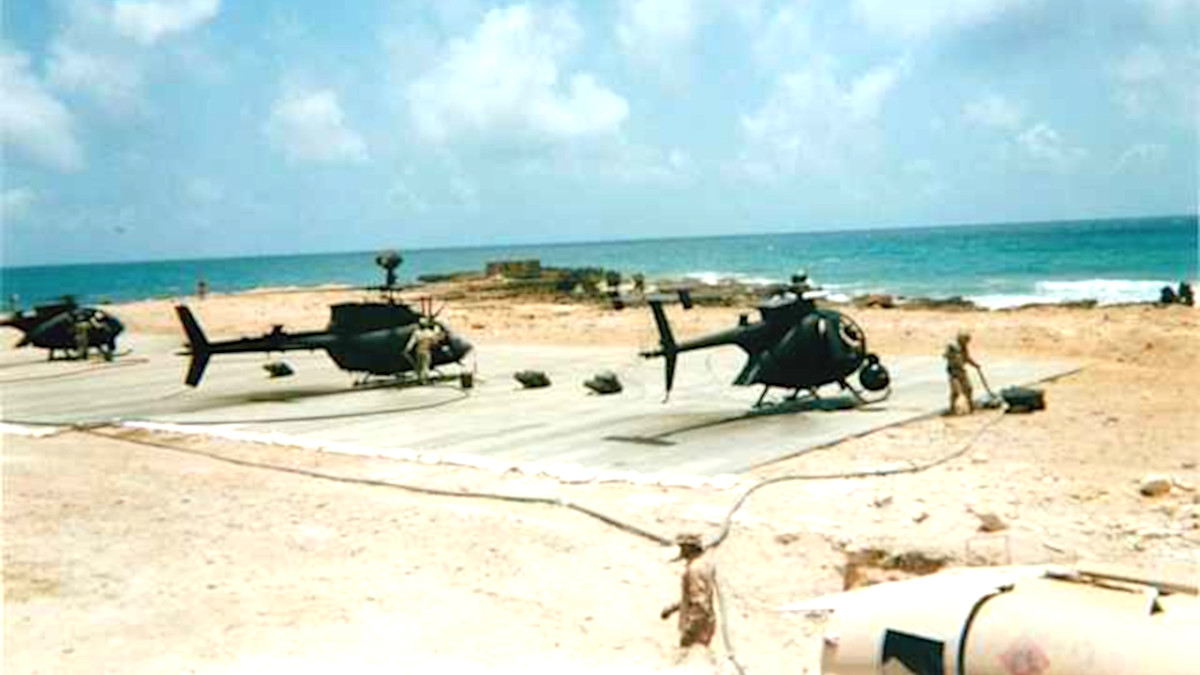
The two helicopters both feature a large “batwing” satellite communications antenna on top of their tail boom, as well as downward facing “sugar scoop” exhausts. This latter feature helped to reduce the helicopter’s infrared signature, making it less vulnerable to heat-seeking surface-to-air missiles.
One of the helicopters has a sensor turret under the nose, similar to the 160ths AH-6s and MH-6s. This could be a Hughes AN/AAQ-16 forward-looking infrared (FLIR) turret, which Raytheon Systems Company continued producing into the 1990s. This system provides infrared full motion day or night video in almost any weather conditions. For years, it was a standard feature on the Army’s special operations AH/MH-6s, MH-60s, and MH-47s, as well as the U.S. Air Force’s HH-60G Pave Hawk rescue helicopters, among other aircraft.
The other helicopter, however, has a much larger turret on a mount on the right side of the fuselage. This is a WESCAM system, which Canadian firm Isolation Stabilization Technologies, or Istec, produced at the time.
The Military Division of Westinghouse Canada originally developed this system for the Canadian military. WESCAM stands for Westinghouse Steered Stabilized Camera Mount. The WESCAM is also a FLIR sensor, but it had greater range and stability compared to the AN/AAQ-16 thanks to a telescopic lens and a more robust gyro-stabilized gimbal. The complete system also featured a data link that could transmit the feed straight back to command centers on the ground.
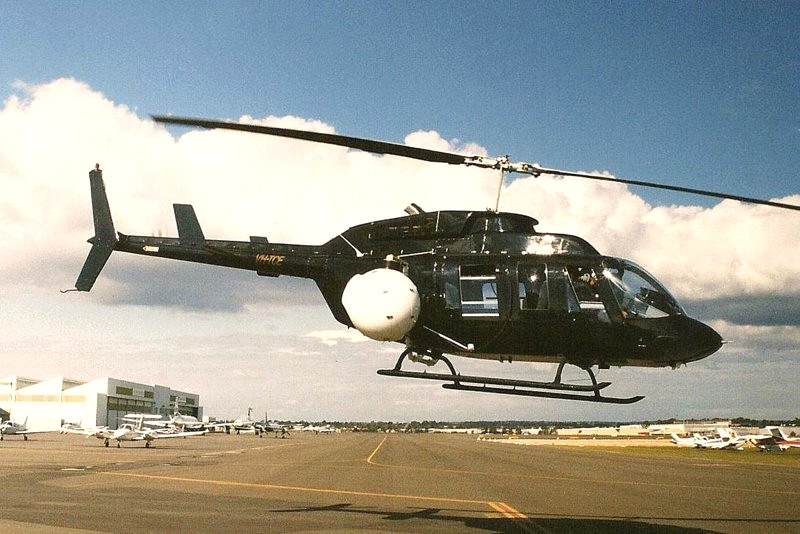
The WESCAM “ball” would have allowed this helicopter to orbit much further away from its target, while still providing important persistent surveillance capabilities. This would have been an essential capability for Task Force Ranger’s mission locate and capture specific individuals.
Since the 1990s, the technology necessary to provide this kind of persistent surveillance has steadily become smaller even while providing much higher fidelity and greater wide-area surveillance functionality. In 2002, L3 Technologies bought WESCAM, which became L3 WESCAM, and the company continues to produce a particularly popular MX line of sensor turrets for aircraft and other platforms.
The helicopter with the ball notably has an additional blade antenna on the right side of the fuselage, as well as one under the forward fuselage. These are often associated with high-frequency radios and other communications systems.
Converted commercial Little Birds
Beyond their specialized equipment, it is also clear that these helicopters are MD Helicopters Model 500s or 530Fs, types that the 160th does not appear to have ever flown. Based on its features and other available information, the far aircraft in the FARP photo appears to be a 530F in that it features a pointed nose. The Army’s special operations AH/MH-6 variants, which Boeing now produces, have rounded noses.
All of these helicopters are derivatives of the Hughes Model 369, which the Army first began flying as the OH-6A Cayuse scout helicopter in 1966. In parallel, Hughes developed the commercial 500 series, which steadily evolved to incorporate more powerful engines and other improvements, including a main rotor with five blades instead of four and a redesigned T-shaped tail.
In 1982, what had become Hughes Helicopters first introduced the pointed nose on the Model 500E. In 1984, McDonnell Douglas bought Hughes Helicopters, renaming it MD Helicopters, and that company introduced the 530F variant that same year. The 530F was a version of the 500E optimized for hot-and-high conditions with a new 650-shaft horsepower Allison 250-C30HU engine.
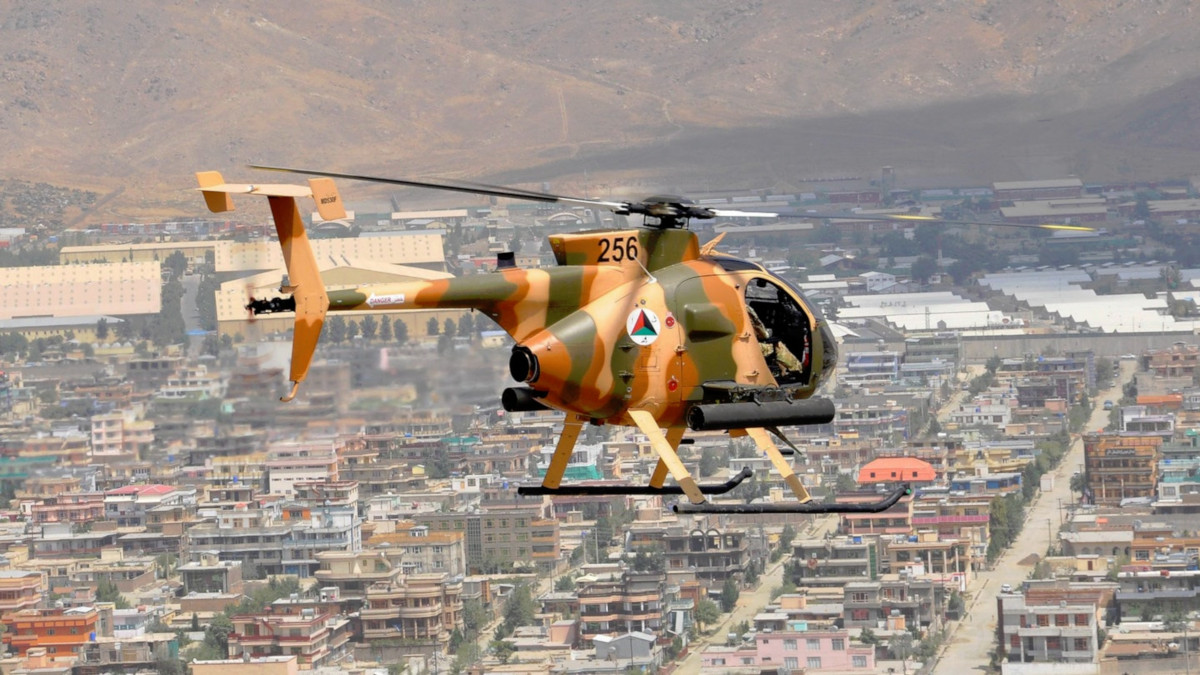
The WESCAM-equipped Little Bird in Somalia may have a rounded nose found the AH/MH-6 Little Birds, as well as on earlier 500-series helicopters, but it has another set of features that identify it as a commercial helicopter. To this day, 500-series helicopters, as seen in the picture of an Afghan Air Force 530F above, feature trapezoidal fins on either side of the T-shaped tail.
The 160th’s AH-6s and MH-6s have arrow-shaped fins. A second picture of the two mysterious helicopters, which appears to have been taken at Mogadishu International Airport, where Task Force Ranger operated from, shows little of the helicopters beyond their distinctly 500-series fins.
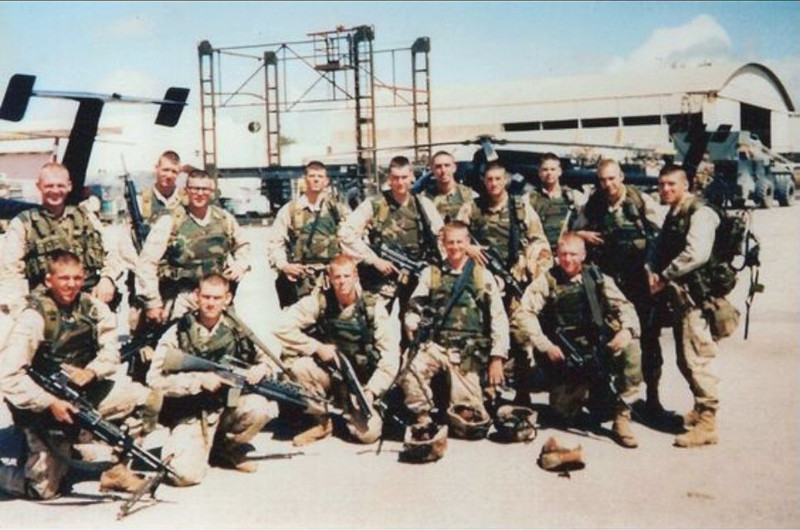
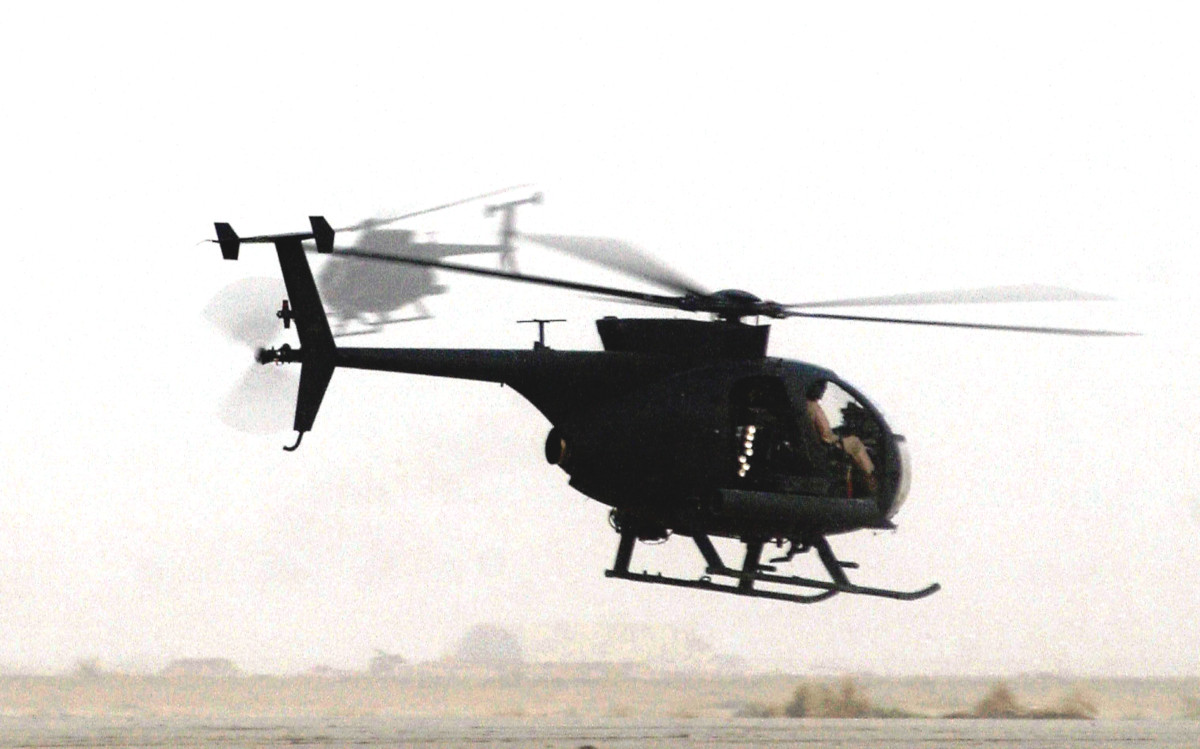
Further adding to the evidence that these helicopters were commercial 500-series helicopters is a curious entry in the operations log from the Battle of Mogadishu on Oct. 3-4, 1993. It reads “Recce launch (2 x H-530 & 1 x OH-58D),” according to Leigh Neville’s Day of the Rangers.
U.S. Army Colonel Lawrence Casper’s memoir also mentions this tasking, with the added note that this was to replace a U.S. Navy P-3 Reef Point intelligence, surveillance, and reconnaissance aircraft that had previously been on station over the city, another type of aircraft we will circle back to later. At the time Casper was head of the 10th Combat Aviation Brigade, 10th Mountain Division. He was in Somalia as the commander of a 3,600-man quick reaction force, known as Falcon Brigade, which was separate from Task Force Ranger and attached to the U.N. force in the country.
There is no indication that the available picture showing the pair of 530Fs with an OH-58D is actually from the Battle of Mogadishu, but it does indicate that this was a common combination for reconnaissance and surveillance operations in support of Task Force Ranger. The OH-58Ds were officially part of Falcon Brigade, but had been “chopped” to the special operations force after its arrival in the country. The Kiowa Warrior in the picture has its own batwing satcom antenna, a feature that was not found on standard Army versions of this helicopter, indicating that this was added during the deployment to link it to the task force’s communications and data networks.
“Shortly after TF Ranger’s arrival, TF Raven chopped the Fort Hood-based OH-58Ds to TF Ranger,” Casper told U.S. Army Major Marshall Ecklund and U.S. Air Force Major Michael A. McNerney during the course of their work on a 2004 joint master’s thesis at the Naval War College. “The OH-58D’s unique mast-mounted optics and FLIR could be ‘down-linked’ directly to TF Ranger’s JOC [Joint Operations Center].”
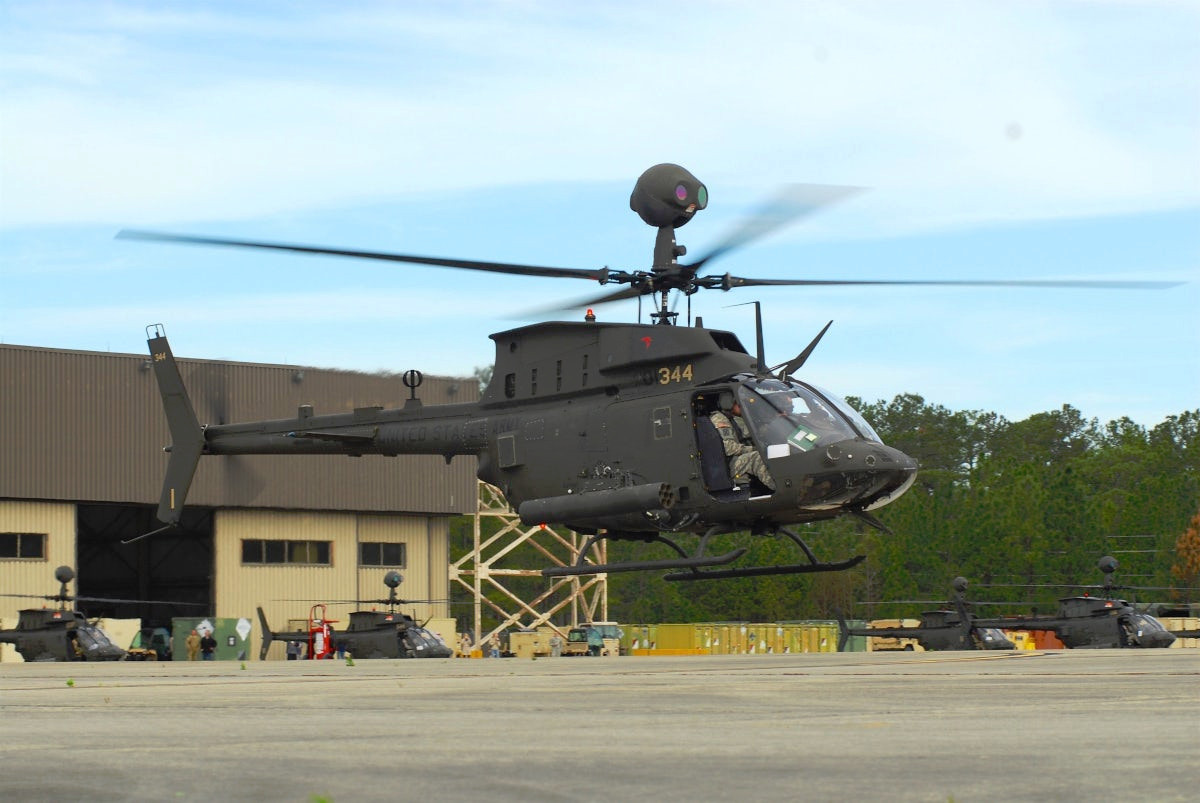
Helicopters from a top-secret unit
All this evidence strongly points to the two 500-series helicopters belonging to a top-secret U.S. Army unit known at the time as the Flight Concepts Division. The service established this entity, in cooperation with the Central Intelligence Agency (CIA), around 1981, at which time it was called Seaspray.
Seaspray’s job was to provide fixed-wing aircraft and helicopters to support “black” covert and clandestine operations, often working together with the Army’s secretive Delta Force and Intelligence Support Activity (ISA), as well as CIA paramilitary elements. MD 500 and 530 helicopters, along with Beechcraft King Airs, some of which were converted to intelligence gathering platforms, initially formed the core of this secret air component, which conducted operations in Latin America, the Middle East, and elsewhere.
In 1987, one of the unit’s Little Birds appeared at Frankfurt Airport in what was then West Germany, which you can read about more here. The helicopter was almost certainly supporting then-U.S. President Ronald Reagan’s visit that year, which included his famous “Tear down this wall!” speech.
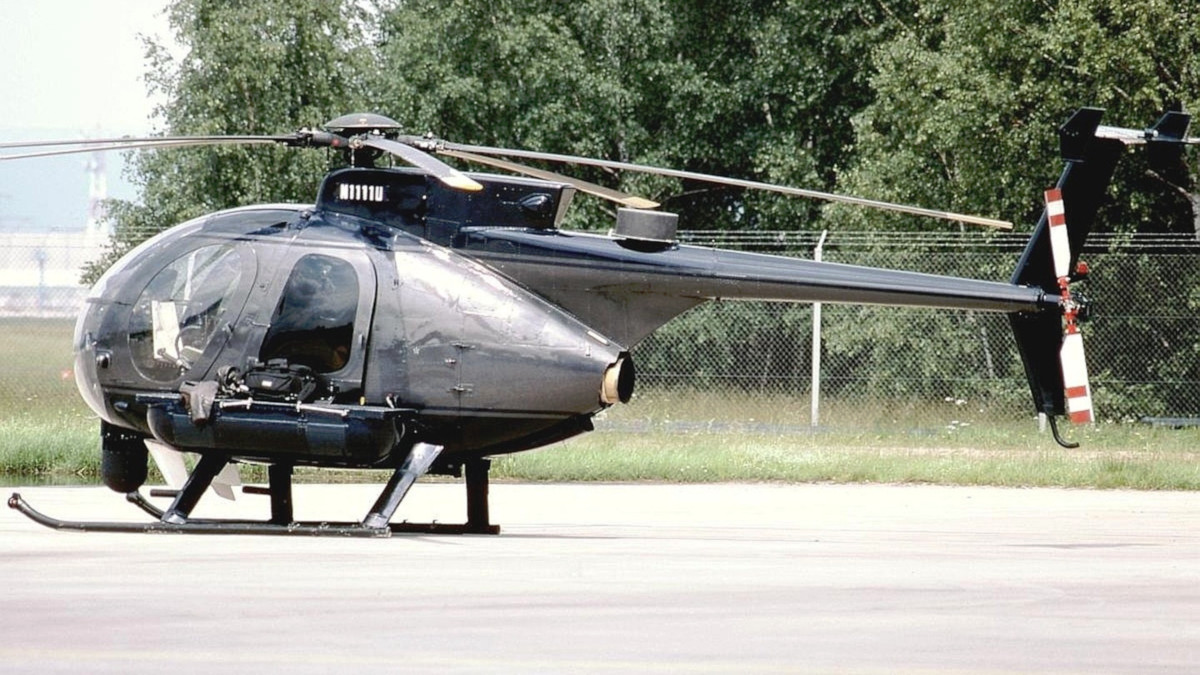
Scandals and leaks to the media about Seaspray and the ISA, the history of which are very much intertwined, prompted the Army to officially shut down those entities in 1989. They never truly went away, though, continuing to operate in the black world under new names and behind new top-secret special access program codewords. To this day, they remain closely tied to the Joint Special Operations Command (JSOC) and the CIA.
By the early 1990s, what the Army had called the ISA had morphed into the blandly-titled Office of Military Support, also known by the codename Centra Spike, and Seaspray had turned into the Flight Concepts Division, which had its own codename, Quasar Talent. You can read more about the Flight Concepts Division in this past War Zone feature on it and other top-secret U.S. military aviation units.
In Somalia, well before Task Force Ranger even touched down, the CIA at least had been in the country performing a variety of missions, including gathering signals intelligence and setting up local human intelligence networks. Day of the Rangers notes that, by the time the special operations force went into action, there were an array of intelligence assets in place and available to support Operation Gothic Serpent that also included elements from the Flight Concepts Division and the Office of Military Support.
In terms of aerial intelligence, surveillance, and reconnaissance platforms, Task Force Ranger could call upon the 500-series helicopters and the OH-58Ds. There were also Beechcraft King Airs with civilian-style paint schemes equipped for intelligence gathering missions, which also could have been from the Flight Concepts Division or the CIA. There was also at least one RG-8A Condor in Somalia, an ultra-quiet, high-flying powered glider that you can read about in more detail here, which may have belonged to the Agency, according to Day of the Rangers.
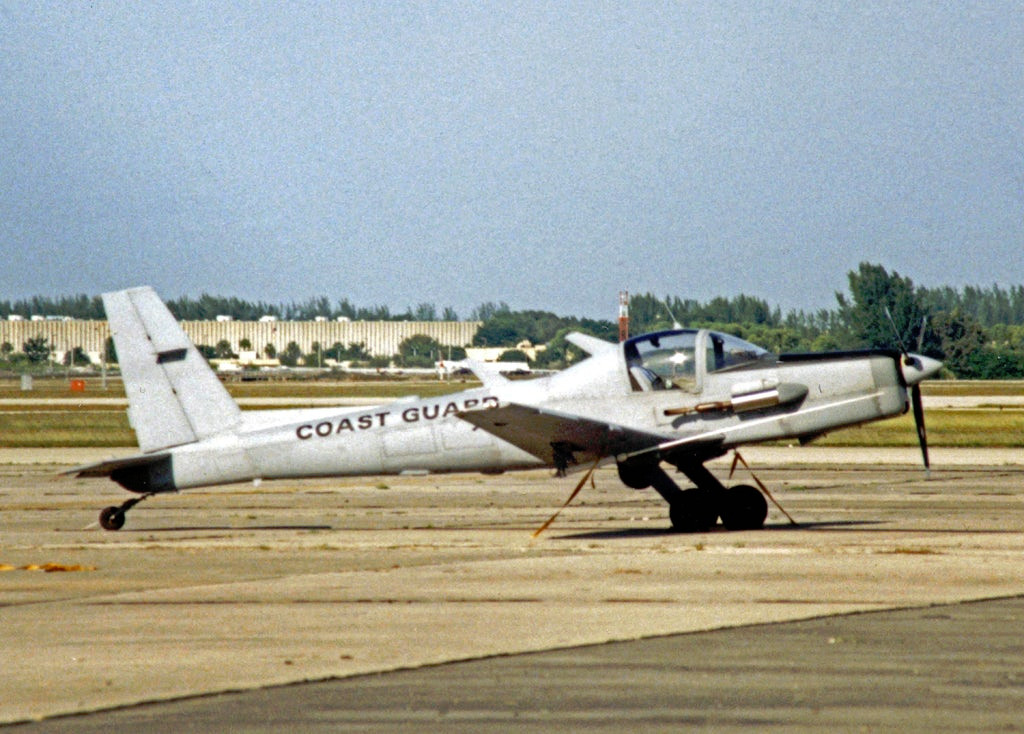
At this time, long-endurance drones such as the MQ-1 Predator, had not yet become a ubiquitous feature of American military operations, meaning that fleets of manned aircraft with state-of-the-art sensors remained the primary means of providing the kind of persistent surveillance necessary to locate and monitor specific locales and individuals, such as Aidid. The 530Fs, especially the one with the WESCAM ball, would have been an important tool for observing the so-called “patterns of life” of individual targets so that Task Force Ranger could determine the best time and place to launch a mission to capture them. The ability to pipe that feed straight into the task force’s Joint Operations Center would have also allowed for more dynamic planning in near-real time.
It’s important to remember that Colonel Casper stated that the pair of 500-series helicopters, along with the OH-58D, were specifically meant to take over for a Navy Reef Point aircraft. Subsequently known by the codename Iron Clad, these “special projects” P-3s are not to be confused with the Navy’s EP-3E Aries electronic intelligence aircraft.
Their exact configuration is classified, and has changed multiple times over the years, but the aircraft flying over Mogadishu on Oct. 3-4, 1993 had a powerful electro-optical and infrared camera suite that could provide full-motion video, according to Day of the Rangers. The Reef Point/Iron Clad aircraft also carry signals intelligence systems and have an array of communications systems and data links to be able to send video and other information to ground control stations.
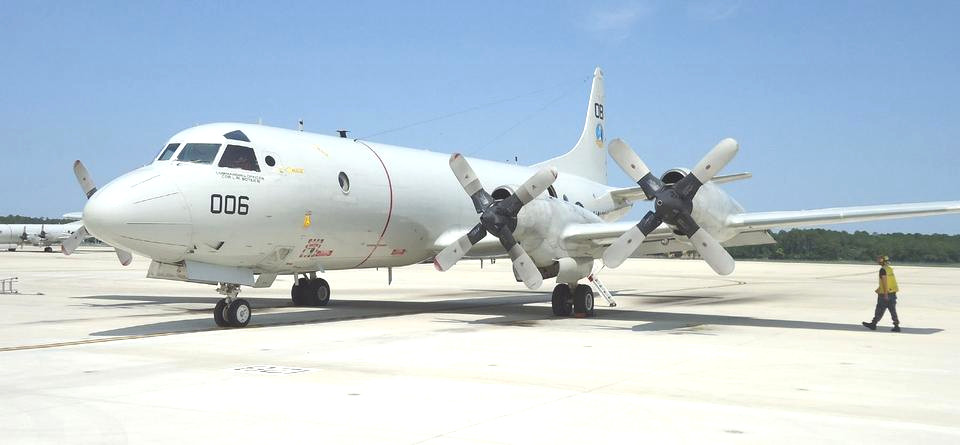
So, it is possible that second 530F may have carried signals intelligence gear to help in initially locating targets for the camera-equipped Little Bird to focus its attention on. There is limited information available about a small number of “EH-6” Little Birds, which may have been assigned to the 160th or Seaspray in the 1980s. Some reports suggest these aircraft were simply communications relay nodes, rather than electronic intelligence platforms.
After Somalia
There remain virtually no details about the exact scope of the Flight Concepts Division’s involvement in Somalia in support of Task Force Ranger, or that of other covert aviation elements, and the full extent of those activities may never emerge. We don’t know what happened to the two 530Fs after their tour in Somalia, either.
Little Birds have remained closely associated with the Flight Concepts Division since then, though the exact composition of its aircraft fleet remains shrouded in secrecy. Around 2016, it appears that it changed its official name again, too, becoming the Aviation Technology Office. It is still based in a highly secure hangar facility at Felker Army Airfield, which is situated within Fort Eustis in Virginia. The unit is now slated to get a large new hangar and a host of other facilities in the coming years.
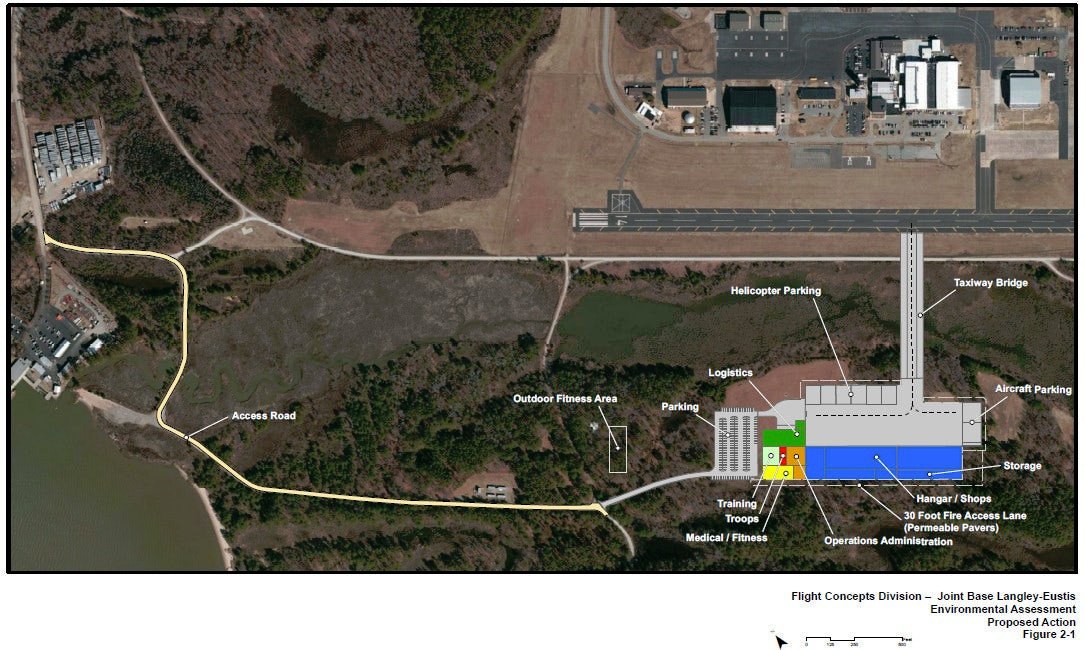
What is well known is that the raid in Mogadishu on Oct 3, 1993, touched off a running battle through the city that stretched into the next day. Somali militiamen allied with Aidid killed 18 American personnel, shot down two Black Hawks, and captured U.S. Army Chief Warrant Officer Michael Durant, a pilot from the 160th.
Nearly two weeks later, Aidid’s men released Durant, along with a Nigerian soldier from the U.N. force in the country who they had captured earlier, to the International Committee of the Red Cross. Operation Gothic Serpent ended days later and Task Force Ranger returned to the United States.
Other American forces remained in Somalia under the U.N. flag until March 1994 and the international mission came to a close completely the following year. Aidid declared himself president in 1995, but received no international recognition. He died the following year in a shootout with militiamen allied with Osman Ali Atto, a former political ally. Task Force Ranger had actually captured Atto in September 1993, but he was out of custody the next year as part of an abortive peace process. He died of natural causes in Mogadishu in 2013.

The Black Hawk Down incident effectively turned Somalia into a no-go zone for the U.S. military for more than a decade. But since 2007, American involvement of the country has been steadily growing.
In 2017, the Trump Administration further expanded the scope and scale of U.S. military operations in the country, ostensibly to combat terrorist groups including the Al Qaeda-linked Al Shabaab and a regional faction aligned with ISIS. There has been a dramatic uptick in recent years in American air strikes in the country, including targeted strikes, along with reports of more operations in the ground in concert with local partner forces.
Maybe, years from now, we’ll learn that elements of the Flight Concepts Division also returned to the region to reprise their intelligence, surveillance, and reconnaissance role or provide other support for this new era of still highly classified operations in Somalia.
Contact the author: jtrevithickpr@gmail.com
